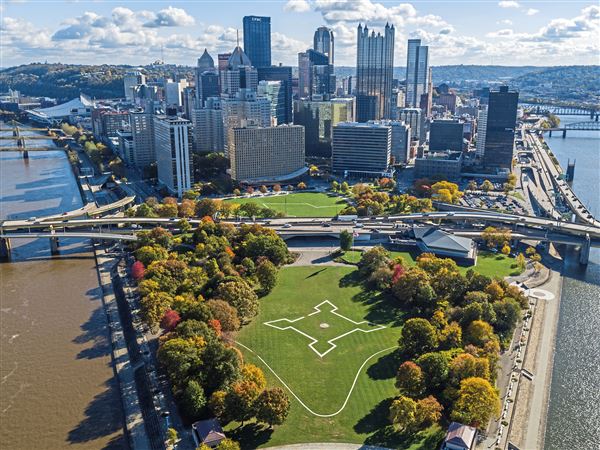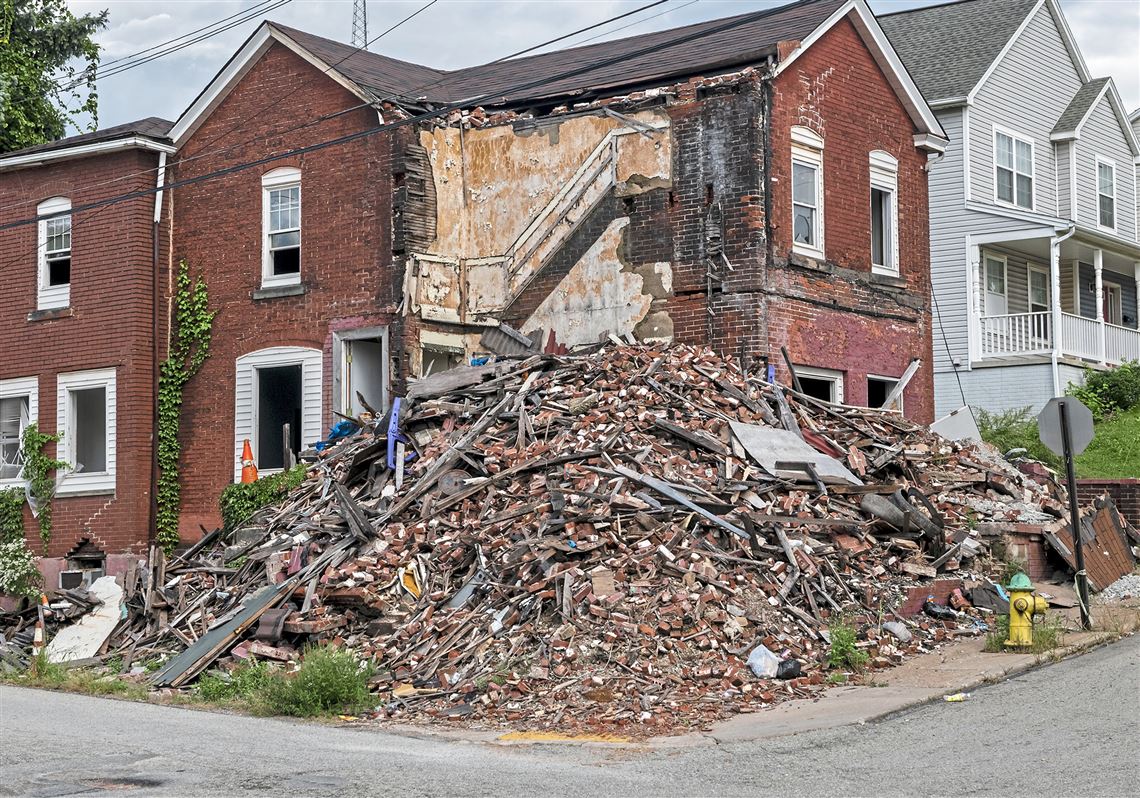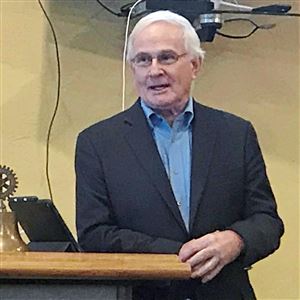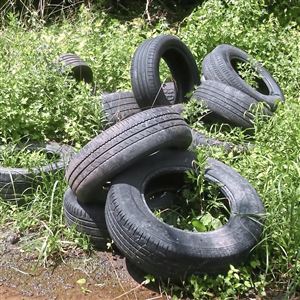The pile of rubble next door didn’t deter Nathan and Christina Van Patter from closing on the $85,000 purchase of a North Braddock house four months ago. They figured the mess would be gone before the leaves fell.
But the heap of brick, wood, metal and trash at 6th Street and Baldridge Avenue was still there last week, a reminder of the difficulties facing the region’s little municipalities — and an example, to some, of the reasons why some of them might cease to exist.
Mr. Van Patter, a 30-year-old social worker and sometime artist whose wife is expecting their first child, came to North Braddock in search of "a model of community that’s different — people see each other, and know each other, and have a different kind of social fabric.” He’s found that.
He didn’t know, though, that he was hitching his growing family’s wagon to a community that is drowning in abandoned homes, to the extent that some officials are talking about throwing themselves on the mercy of the county.
“All of these little municipalities in the area, we’re in the same situation,” said John Vahosky, president of North Braddock council. The gap between needs and resources is vast, he said, “and every hour, it’s getting bigger and bigger.”
Seeing that, Allegheny County executive Rich Fitzgerald has swung behind a new concept: voluntary disincorporation of municipalities, which would shed their local governments and rely on the county for services.
“Probably 10 years ago, 20 years ago, there would have been much less enthusiasm” for such an option, Mr. Fitzgerald said last week. But southwestern Pennsylvania has seen “a spread between the haves and the have-nots within our region,” he said, and some communities should ask "where's the trend going?"
Would any government really call it quits?
“From a manager’s standpoint, I see that as the answer for some of these distressed communities,” said North Braddock Borough manager Doug Marguriet, who has talked about the option with his council’s members, though they have not voted.
Mr. Van Patter just wants the rubble removed — before his child starts toddling around.
“I don’t super love having an abandoned house next door,” he said. "I saw people go in there the other night. … I know that the money’s hard, but I hope they find a way to get the house out.”
Biting the bullet
Many of North Braddock’s 4,731 residents come home from work via Route 30, Yost Boulevard and 6th Street, then turn left on Baldridge. So when, in February, the abandoned storefront and apartments at 6th and Baldridge collapsed into the intersection, the borough immediately hired a contractor to push the ruins back, at a cost of $9,000.
The borough then applied to the county for emergency demolition money to finish the job. The county, though, ruled that the emergency had passed, taking the position that the borough can redirect some of the $100,000 in grants it has been awarded this year to demolish 10 other houses.
A simple house demolition can cost as little as $8,000. But because asbestos infests the plaster and tiles at 6th and Baldridge, initial estimates for that job are $35,000, according to North Braddock officials. That would eat up 10 percent of the borough’s annual property tax receipts, or 12 percent of its public works budget.
That’s one house. The borough hosts 400 abandoned houses. It's become a psychological burden, said Mr. Marguriet. “Just think of a whole generation that has grown up in this atmosphere.”
The cost of razing them all? “We probably need $3 million to $4 million,” he said. That’s far more than the borough’s annual budget.
“Everybody’s reaching to the county,” Mr. Vahosky said. “The time is coming that the big guy is going to have to come in and do more.”
The county helps municipalities with demolitions using its federal community development grant, which this year amounts to $13 million. But federal rules limit the amount of that which can be spent on demolition.
A new attention to asbestos, meanwhile, has pushed up demolition costs. The county Health Department in 2015 realized that municipalities were tearing down houses without testing for asbestos. "It's not unusual to see a demolition going on in the neighborhood, and kids and other people will sit around and watch it," said Jim Kelly, deputy director for the environmental health bureau of the Health Department. Dust from asbestos-laced plaster and pipe insulation can linger in the air, setting the stage for cancers that won't appear until decades later.
The federal Environmental Protection Agency confirmed that every demolition should be preceded by an asbestos test. The asbestos test adds $400 to $800 to the typical demolition bill, said Shannon Sandberg, the Health Department's asbestos abatement administrator. If there's asbestos in the plaster — as occurs in perhaps one in six houses — a demolition bill can double.
“Yeah, [demolition has] become a bigger cost, and [municipalities] have to make decisions," said Mr. Fitzgerald. Can the county give them more money? “We can try, but until community development block grant funding starts to take on more of the burden for that, I don’t know where those funds will come from.”
The bottom line, said Mr. Marguriet: “So we’re going to have to bite the bullet.”
“Like a bomb hit it”
North Braddock overlooks U.S. Steel's Edgar Thomson Works, and, across the river, Kennywood. It hosts the Grandview Golf Course and a mansion built for Charles M. Schwab.
But swaths of the borough look “like a bomb hit it,” said Mayor Tom Whyel, first elected in 2009. Longtime residents died and left homes to children who “just let the houses go.”
“Since I’ve been there, we have taken out a couple hundred houses,” he said. But there are no fewer condemned houses today. “It’s a never-ending, vicious cycle.”
“The county’s got to step in. They’ve got the resources. They’ve got the professional staff,” said Mr. Marguriet.
In May, with Mr. Fitzgerald’s backing, legislators introduced bills that would allow Allegheny County municipalities to dissolve.
If it passed, municipal leaders and the county could negotiate an "essential services transition plan" to shift the local government’s debts, pension obligations, contracts, property, responsibilities and taxing authority to the county. There would be a public hearing, a council vote and a ballot referendum. If the plan passed, the municipality would cease to exist, and its residents’ interests would be represented by the county executive, their county council member and a "district advisory committee" of three residents.
"There are some communities that are struggling and simply don't have the necessary tax base to provide the municipal services that they are supposed to provide," said state Senate Minority Leader Jay Costa, D-Forest Hills, prime sponsor of one of the bills. (The other was introduced by Rep. Dom Costa, D-Stanton Heights.)
“You’d probably see some economies of scale around things like public safety,” public works and parks after disincorporation, said Mr. Fitzgerald, noting that it would be "voluntary, not forced takeover or anything like that.”
“I don’t think that’s the answer,” said Mr. Whyel. “You have no control then.”
Mr. Marguriet, though, sees control slipping already. “We’re holding on just by our fingernails.”
“We need that bigger governing body to come in and try to help us,” said Mr. Vahosky.
Two blocks, 16 vacants
"It's peaceful, very peaceful," in North Braddock, said Marna Watson, 55, who has rented a Kirkpatrick Street house since 1994, raising two sons two blocks from the police station.
But a minute later, a series of loud cracking sounds and a whoosh interrupted her. "What the heck?" she said.
She walked past the abandoned house next door, then eyeballed the next house — part of which just slid down the hillside. "The house is finally caving in. It fell in. Oh, my goodness!” She called it "very scary."
On her block of Kirkpatrick, six of 11 houses have been abandoned. On the next block, it’s 10 of 22.
Streets like this dot the Mon Valley, despite the county dedicating 43 percent of its federal development funds to that region. One municipality, McKeesport, has jump-started its demolition efforts, funding a 300-house blitz using a fraction of the proceeds from the $159 million sale of its sewage authority to Pennsylvania American Water.
North Braddock doesn’t have a big asset to sell. It razes nine to 15 houses a year.
The borough hasn’t gotten to what Shelley Sboray calls “a raccoon hotel” across from her home on Kirkpatrick. “If you sit outside at dusk, you will see them come out. I have seen a mother raccoon come out with a whole bunch of babies behind her, and they climb down the ivy.”
The 53-year-old home care worker has complained, and has been advised to call animal control and request a trap.
“I know they’re broke. I know they don’t have money.” she said. She would hate to see the borough dissolve, especially since it would lose its police. “But something needs to be done.”
Rich Lord: rlord@post-gazette.com or 412-263-1542
First Published: September 24, 2018, 12:57 p.m.























